Sorry you are going through this. It really does not have to be this way However unfortunately the pool industry seems to have more than it's fair share of hacks. I was looking back over the pics trying to come up with a reasonable approach to this mess and discovered something even more concerning. Looking at the original dig I was having a hard time believing that the sand layer just happened to be at the correct elevation for all the walls. Turns out it was not. In one pic I can clearly see the spa shelf has a loam layer under it and a dusting of sand on top. That is where I would put the brakes on and reassess letting these clowns finish your build. I do not know of any soils engineers that would let that one fly. Perhaps @MinerJason could chime in and give you the likely hood of your spa settling. Sorry to increase your stress level but I really think you should get a few more opinions on letting this PB continue. @jimmythegreek builds pools in your area, Hopefully he can chime in as well.
New In Ground Pool - NJ, Closing Time - have some questions
- Thread starter jonnyd91
- Start date
You are using an out of date browser. It may not display this or other websites correctly.
You should upgrade or use an alternative browser.
You should upgrade or use an alternative browser.
Sorry you are going through this. It really does not have to be this way However unfortunately the pool industry seems to have more than it's fair share of hacks. I was looking back over the pics trying to come up with a reasonable approach to this mess and discovered something even more concerning. Looking at the original dig I was having a hard time believing that the sand layer just happened to be at the correct elevation for all the walls. Turns out it was not. In one pic I can clearly see the spa shelf has a loam layer under it and a dusting of sand on top. That is where I would put the brakes on and reassess letting these clowns finish your build. I do not know of any soils engineers that would let that one fly. Perhaps @MinerJason could chime in and give you the likely hood of your spa settling. Sorry to increase your stress level but I really think you should get a few more opinions on letting this PB continue. @jimmythegreek builds pools in your area, Hopefully he can chime in as well.
Both the shallow and deep ends of the pool, I can assure you are on virgin sand ground. The spa shelf is just that, a shelf for the spa to slip into. The base of the spa where all the weight transfers onto will be sitting on cinder blocks that come in complete contact with the virgin sand ground. In defense to the pool builder, I have been watching every thing they do and I have not seen them try to cut corners or do shoddy work. They seem to double and triple check their measurements and take their time.
In reference to the concrete, this is being subcontracted. I even spoke to multiple contractors and they all do the same thing around here.
So at this point my only choice is to mitigate what I can to lay down the "best for my area" ground work that will decrease the failure % of the decking being installed.
So that is where Im at with that. Im open to any and all recommendations given the confines of my situation. I want to do it right, but if I roll up trailing a bobcat rental my wife will kill me, I have a bad habit of getting too involved with home projects ever since I finished my basement (while also hiring a contractor to build it out)
So what creative ideas do we have to try and get a good balance?
The base of the spa where all the weight transfers onto will be sitting on cinder blocks that come in complete contact with the virgin sand ground.
Well that sounds acceptable to support the base of spa . I will have to retract my "hacks" statement . Although I am not a big fan of leaving the rest of the organics down there. I find it hard to believe it is accepted practice to place concrete directly on 3'-4' of organics including the sod layer. That would keep me up at night... They definitely do things different down there in Jersey..
So what creative ideas do we have to try and get a good balance?
Not sure if there is a middle ground worth perusing. If the PB puts in the stone It would be very difficult to then remove all the organics without the stone falling away from the pool. Perhaps the middle ground could be to let the PB install the stone then get a different contractor to remove just 2' of the organics then install stabilization fabric then the crushed concrete. This at least would get you down to undisturbed material and remove the sod layer. That would be my first thought.
Mot trying to stress you but I agree with RichD. PB has his quoted price and all this talk is change orders. Hes not doing it for nothing. If he knows the area he should know how much loam is there. That's worth 300 a load here exported. When he dug he should have removed the topsoil down to sand and started backfill of the deck area and left backfill stone on top for the overdig while the big machine was still there. No matter what you do, you cannot get a proper base on it for the long haul. If PB is just doing pool amd you have your own concrete guy see if you can find a small sub with a dump amd track machine amd remove all that after hes done backfilling. If PB is coming back for the spoils see if he will do it. Dont pay 26 a yard for stone find the nearest quarry and get some prices. Where in NJ are you is there a Weldon near you? I pay 450ish for a tri axle delivered of DGA or clean stone. Dont let material scare you it's way more expensive amd dis heartening to have cracked or sunken pool deck
The only issue I see with that approach is stone will typically be fall at a 1 to 1 slope. If the next contractor tries to remove 4' of loam I would fear too much stone would fall away from the pool and if he has poured a top collar you would loose that as well. It would obviously be best to address the issue now and do it correctly. Jimmy is spot on about this all being a change order and the PB being payed. The moment they saw that much loam the the issue should have been presented to you and addressed while the excavator was on site. The additional pressure the PB is putting on you saying you get 1 day with a bobcat and that's it is BS... No matter how busy they are, They have a obligation to do the job correctly (and get payed for unforseen extras) and let the next customer wait, just as the next customer would want them to do the same. I am still of the mind that someone is handing you a big line of BS telling you this standard procedure (just my humble opinion).If PB is just doing pool amd you have your own concrete guy see if you can find a small sub with a dump amd track machine amd remove all that after hes done backfilling.
phonedave
Well-known member
- May 30, 2012
- 1,936
- Pool Size
- 17000
- Surface
- Vinyl
- Chlorine
- Salt Water Generator
- SWG Type
- Hayward Turbo Cell (T-CELL-5)
Well that sounds acceptable to support the base of spa . I will have to retract my "hacks" statement . Although I am not a big fan of leaving the rest of the organics down there. I find it hard to believe it is accepted practice to place concrete directly on 3'-4' of organics including the sod layer. That would keep me up at night... They definitely do things different down there in Jersey..
I used to work as a soils engineer in Jersey. We know how to do things correctly, we just have certain contractors who do things incorrectly (or just don't know any better). Years ago I was on a job site building a township library, I was rejecting almost every 4th load of fill as unacceptable. I got pulled off that job (to my protest) to work a condo complex that was going in - mainly because the township was complaining about how much they were being charged for me to "Watch dirt being dumped". About a week later my boss called and asked if I had seen the headline in the local paper "What is buried at the township library?" As soon as they pulled me off that job the contractors starting bringing in fill that had roots, branches, and other organic material in it. People living in the area took pictures. It is a good thing I kept detailed records. We dug about 15 test pits on the site. Every place where we dug that I had in my records came up clean. Places where fill was placed where I was not on the job was loaded with unacceptable fill.
Anyway - to the OP: You should not have organic material (Loam, topsoil, etc) under anything you are building. As was said, there should be no cost to remove topsoil from your site - it is worth money. You should then fill the area with clean fill. It does not have to be DGA or 3/4 clean, or road base or anything with any sort of ASTM specification coming from a quarry. It just has to be clean fill. They could have used the virgin soils from your pool excavation, very often there is a construction site nearby that is looking to get rid of clean fill, as was said about recycled concrete - it is an option. The only thing that gives me pause about using random fill is that it does not seem like anybody really knows there stuff on the job. Most clean fill is going to be ok. As long as it is not an expansive soil, or heavy clay. But it does need to be compacted correct. Not saying somebody needs to run a full proctor test, generate a compaction curve, and test each lift going in, but it can't just be "blown in two feet deep and left to settle for a few weeks either:. 6" lifts and hit with a heavy plate compactor (or a small double drum) should do the trick.
Thank you for confirming that not everybody in Jersey disregards standard, time proven practices.
That was one of the first things I noticed, that they clearly just mixed all that nice sand in with the topsoil.
They could have used the virgin soils from your pool excavation,
That was one of the first things I noticed, that they clearly just mixed all that nice sand in with the topsoil.
Agreed.. your story only sends this point home all too clearly.. In addition acquiring fill like that on a larger job is okay however on the smaller jobs trying to line up a small amount of fill getting loaded and delivered from another site can quickly turn into a nightmare and cost you much more in time than it would have to just purchase the material from a gravel pit which delivers every day.The only thing that gives me pause about using random fill is that it does not seem like anybody really knows there stuff on the job.
Some of us in NJ are OCD freaks. I have a rule on my site. Once ita touched it doesmt go back. I've kicked many off the site and now its standard practice. My train of though is this....if I'm not making enough on the average 60k pool build to remove a load or two of our Crud clay and replace with cheap road base or even cheaper RCA I'm not doing it right. I have done 1 concrete deck all year, here it's all pavers. With the clay dirt I have here I need minimum 10" of base amd geotextile under it to sleep at night. Base material is an insurance policy for me. I figure it into every job and plan for Crud dirt always. Swinging material in and a guy on the plate running around goes very fast actually. It's a nightmare to pull up pavers and fix settling I'd rather go to the dentist or be a covid Guinea pig
I guess I just don’t know enough about all this. I was under the impression I could put the concrete over undisturbed soil.
Are you all saying I should be removing 4’ of soil everywhere I plan to install concrete?
the change in soil color I think you are seeing is from fill that the builder brought in when they graded the yard when the house was built.
I have no clue really what to do now, I would be doing this all on my own. 5 people put pools in here and probably didn’t bat an eye at the soil. I know for sure none of them backfilled with gravel.
@jimmythegreek I am in central nj right by great adventure. I don’t know of any quarry’s here. I’m at a loss now, I thought I was doing good backfilling with gravel but never expected to have to dig 4’ down 10-12’ around the entire pool.
at this point I just want to fill in the hole.
Are you all saying I should be removing 4’ of soil everywhere I plan to install concrete?
the change in soil color I think you are seeing is from fill that the builder brought in when they graded the yard when the house was built.
I have no clue really what to do now, I would be doing this all on my own. 5 people put pools in here and probably didn’t bat an eye at the soil. I know for sure none of them backfilled with gravel.
@jimmythegreek I am in central nj right by great adventure. I don’t know of any quarry’s here. I’m at a loss now, I thought I was doing good backfilling with gravel but never expected to have to dig 4’ down 10-12’ around the entire pool.
at this point I just want to fill in the hole.
Are you all saying I should be removing 4’ of soil everywhere I plan to install concrete?
To do it correctly, Yes. All of the black organic layer should be removed. As stated earlier what can be done in cases of very deep organics is to remove a minimum of 24" of material down to undisturbed soil then place a stabilization fabric then backfill with a structural material (perhaps @phonedave could give his opinion on this). This is usually only done in peaty bogs where the water table is a factor as well. However If you really only have 3-4' and all that nice sand below it would just make sense to remove it all if some of the cost can be recovered in the export.
the change in soil color I think you are seeing is from fill that the builder brought in when they graded the yard when the house was built.
It does look like a layer about 1/2 way down. This is most likely just the extra topsoil the builder graded out.
. 5 people put pools in here and probably didn’t bat an eye at the soil. I know for sure none of them backfilled with gravel.
Your neighbors might not have had as much topsoil on there sites. Being a end lot your lot could have been a stockpile/ fill area. You never know what the developer did. I would reach out to as many as you can and ask how there build went. Have they all used the same pool builder?
phonedave
Well-known member
- May 30, 2012
- 1,936
- Pool Size
- 17000
- Surface
- Vinyl
- Chlorine
- Salt Water Generator
- SWG Type
- Hayward Turbo Cell (T-CELL-5)
To do it correctly, Yes. All of the black organic layer should be removed. As stated earlier what can be done in cases of very deep organics is to remove a minimum of 24" of material down to undisturbed soil then place a stabilization fabric then backfill with a structural material (perhaps @phonedave could give his opinion on this). This is usually only done in peaty bogs where the water table is a factor as well. However If you really only have 3-4' and all that nice sand below it would just make sense to remove it all if some of the cost can be recovered in the export.
It does look like a layer about 1/2 way down. This is most likely just the extra topsoil the builder graded out.
Your neighbors might not have had as much topsoil on there sites. Being a end lot your lot could have been a stockpile/ fill area. You never know what the developer did. I would reach out to as many as you can and ask how there build went. Have they all used the same pool builder?
If somebody has more than 24" of topsoil, removing 23" and placing a geogrid before backfilling should be fine for a patio - keeping in mind there are other aspects to consider as well, but generally yes it is OK.
There are many ways to stabilize soil other than removing the organic material (I took a whole course in Engineering Ground Modification" but none of them are practical for a backyard pool.
For the OP, here is what likely happened when your house was built.
The existing elevation was likely low
The builder first stripped off any topsoil and sold it
Then the builder trucked in fill (non-organic structural fill). Maybe they had an engineer test it, maybe not. Or if there was an existing slope they may have just cut and filled right on site.
When placing that fill, they likely compacted it - I say likely because usually the town will check up on it. Not as closely as having an inspector / engineer on site, but they drive by and make sure there are at least compactors on site.
The contractor then built the house.
The contractor then trucked back in topsoil, and spread it around the backyard (or depending on the area, the time frame, and other factors, may has just stockpiled the original topsoil on site)
The sandy soils you are seeing were placed there by the contractor, but they can be considered virgin soils for these purposes. They have been in place for a number of years, were compacted when placed, and have had a surcharge on them as well.
My house was built in a marshy area. I have top soil, about 36" of clayey sands (fill) and then clay. the clay layer creates a temporary perched water table every spring. We have in ground pools in town, with extensive dewatering systems (and a robust basement waterproofing contractor industry)
If somebody has more than 24" of topsoil, removing 23" and placing a geogrid before backfilling should be fine for a patio - keeping in mind there are other aspects to consider as well, but generally yes it is OK.
There are many ways to stabilize soil other than removing the organic material (I took a whole course in Engineering Ground Modification" but none of them are practical for a backyard pool.
For the OP, here is what likely happened when your house was built.
The existing elevation was likely low
The builder first stripped off any topsoil and sold it
Then the builder trucked in fill (non-organic structural fill). Maybe they had an engineer test it, maybe not. Or if there was an existing slope they may have just cut and filled right on site.
When placing that fill, they likely compacted it - I say likely because usually the town will check up on it. Not as closely as having an inspector / engineer on site, but they drive by and make sure there are at least compactors on site.
The contractor then built the house.
The contractor then trucked back in topsoil, and spread it around the backyard (or depending on the area, the time frame, and other factors, may has just stockpiled the original topsoil on site)
The sandy soils you are seeing were placed there by the contractor, but they can be considered virgin soils for these purposes. They have been in place for a number of years, were compacted when placed, and have had a surcharge on them as well.
My house was built in a marshy area. I have top soil, about 36" of clayey sands (fill) and then clay. the clay layer creates a temporary perched water table every spring. We have in ground pools in town, with extensive dewatering systems (and a robust basement waterproofing contractor industry)
The soil here is sandy, the builder trucked in the fill and also had a large berm in the back yard from the foundation overdig.
I was here when they were building the house and saw it from start to finish. Al that sand is virgin ground.
the builder trucked in the fill
Interesting. It does not look like a area that would require a lot of fill. I would have assumed he would have removed that top 18"-2' of loam then raised the house elevation 1-2' at most then just barely had enough sand from the dig to backfill the walls and used the loam to grade everything off, wich is that top 18" layer you can see in the pool dig profile.
How much fill did he have to bring in?
Interesting. It does not look like a area that would require a lot of fill. I would have assumed he would have removed that top 18"-2' of loam then raised the house elevation 1-2' at most then just barely had enough sand from the dig to backfill the walls and used the loam to grade everything off, wich is that top 18" layer you can see in the pool dig profile.
How much fill did he have to bring in?
You can see in the last pic , that was dirt trucked in.
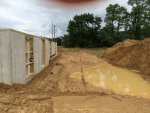
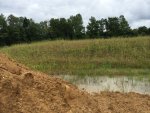
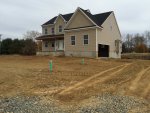
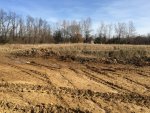
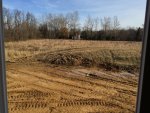
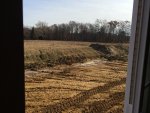
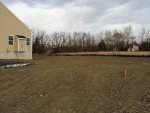
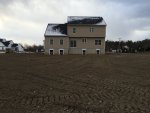
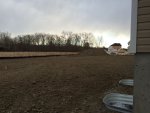
Your house design leaves most of the foundation out of the ground so they did not have a tremendous amount of fill from the dig. Your pics do clearly show they stockpiled the loam in the pool area so unfortunately that area was probably already a bit low for the new grades so the loam just got left there. So as far as comparing your site the the rest of the development they could have much different site elevations so might not have had that much loam to deal with.
Try not to get too stressed out over all this. I would let the PB know you spoke with a soils engineer and he recommended not placing concrete on that much top soil and sod so you are not comfortable with there proposed approach. Ask him for a estimated cost to remove the organics and replace with structural fill in lifts. This will most likely involve brining a excavator to the site. If he refuses to help then let him finish the pool as he would have including bringing the elevations to a finish grade. Then if time permits this fall (or next spring) get a separate contractor to remove and replace the organics and prep for the concrete pad. If they can not remove all the organics because it will cause too much stone to fall away from the pool then just remove the 2' and use the stabilization fabric.
You can also use the frost this winter to your advantage. If you place hay on the proposed dig areas a excavator can come in after a heavy frost and drive the trucks over the frost to make the job much easier. These contractors are very slow at that time of year and are sometimes looking for work. Of course if we get a lot of snow than it can become counter productive, but you will be in good shape to get a early dig in the spring before the frost breaks.
Try not to get too stressed out over all this. I would let the PB know you spoke with a soils engineer and he recommended not placing concrete on that much top soil and sod so you are not comfortable with there proposed approach. Ask him for a estimated cost to remove the organics and replace with structural fill in lifts. This will most likely involve brining a excavator to the site. If he refuses to help then let him finish the pool as he would have including bringing the elevations to a finish grade. Then if time permits this fall (or next spring) get a separate contractor to remove and replace the organics and prep for the concrete pad. If they can not remove all the organics because it will cause too much stone to fall away from the pool then just remove the 2' and use the stabilization fabric.
You can also use the frost this winter to your advantage. If you place hay on the proposed dig areas a excavator can come in after a heavy frost and drive the trucks over the frost to make the job much easier. These contractors are very slow at that time of year and are sometimes looking for work. Of course if we get a lot of snow than it can become counter productive, but you will be in good shape to get a early dig in the spring before the frost breaks.
Last edited:
Your house design leaves most of the foundation out of the ground so they did not have a tremendous amount of fill from the dig. Your pics do clearly show they stockpiled the loam in the pool area so unfortunately that area was probably already a bit low for the new grades so the loam just got left there. So as far as comparing your site the the rest of the development they could have much different site elevations so might not have had that much loam to deal with.
Try not to get too stressed out over all this. I would let the PB know you spoke with a soils engineer and he recommended not placing concrete on that much top soil and sod so you are not comfortable with there proposed approach. Ask him for a estimated cost to remove the organics and replace with structural fill in lifts. This will most likely involve brining a excavator to the site. If he refuses to help then let him finish the pool as he would have including bringing the elevations to a finish grade. Then if time permits this fall (or next spring) get a separate contractor to remove and replace the organics and prep for the concrete pad. If they can not remove all the organics because it cause too much stone to fall away from the pool then just remove the 2' and use the stabilization fabric.
You can also use the frost this winter to your advantage. If you place hay on the proposed dig areas a excavator can come in after a heavy frost and drive the trucks over the frost to make the job much easier. These contractors are very slow this time of year and are sometimes looking for work. Of course if we get a lot of snow than it can become counter productive, but you will be in good shape to get a early dig in the spring before the frost breaks.
Ok, let me play Devils Advocate here.
I did some quick calculations, right now the cheapest place i can find #57 is 26.50 a ton. It looks like (doing your plan) that It will take over 150 tons (6+ truckloads) to backfill the pool and the concrete area.
So Im looking at for arguments sake $3500.00 in material alone. Right now they are charging me 1K, extra just to backfill the pool alone with rock. So we are at $4500.00.
Im going to guess if I ask them how much to come back ant pull more dirt out it will be at least 2k. So we are at $6500.00 now. I hate to bring money into it but for the sake of this exercise, i am paying $8500.00 to install the concrete decking.
There has to be a compromise where this is cost effective.
My plan (thinking out loud):
Remove the sod layer where the concrete decking is.
Pull back the over dig topsoil and create a berm around the pool where the decking will be.
Backfill the pool with gravel
Fill the voids up to the berm where the decking will be with gravel, the berm will hold in any gravel so I can make a fairly flat surface.
Next year they install the concrete decking
Grade out the topsoil berm away from the concrete to create the finished grade (I assume this holds in some of the gravel under the decking so i would just need to be careful grading)?
I have to think that in my scenario, the decking 3ft around the pool including the coping will be completely solid.
In a perfect world I would love to do what you are recommending. Logistically I wouldn't know who to call, where to begin or justify the potential of spending close to 10k.
So lets talk failure rate
Percent that the decking fails in each scenario:
- Backfill with dirt and grade the topsoil around the pool and install deck next year?
- Backfill around the pool with gravel and then back fill with dirt, install decking next year?
- My Plan?
- Your plan?
I m not saying I wont pursue your plan, but I need a backup plan that makes sense for me.
I thought we were talking about using the crushed concrete under the deck. How much will that cost delivered?
I thought we were talking about using the crushed concrete under the deck. How much will that cost delivered?
like 6 bucks a ton difference
So that's 900.00 . I guess that would have to be a judgment call based on how much extra they would charge for the compaction in lifts. If you can find it, You could also use a sandy fill as Dave mentioned then use the crushed concrete or #57 for the final 6". Some gravel pits do carry sandy fill.like 6 bucks a ton difference
The one issue I would have with your proposal would be you are leaving the loose layer that the builder dozed out. I would not think it would be worth the effort to remove the sod then leave that extra 12-18". Getting down to the undisturbed loam would be the bare minimum in my opinion. Then once your that deep is it really worth leaving that other 12-18"... ¯\_(ツ)_/¯
Thread Status
Hello , This thread has been inactive for over 60 days. New postings here are unlikely to be seen or responded to by other members. For better visibility, consider Starting A New Thread.

